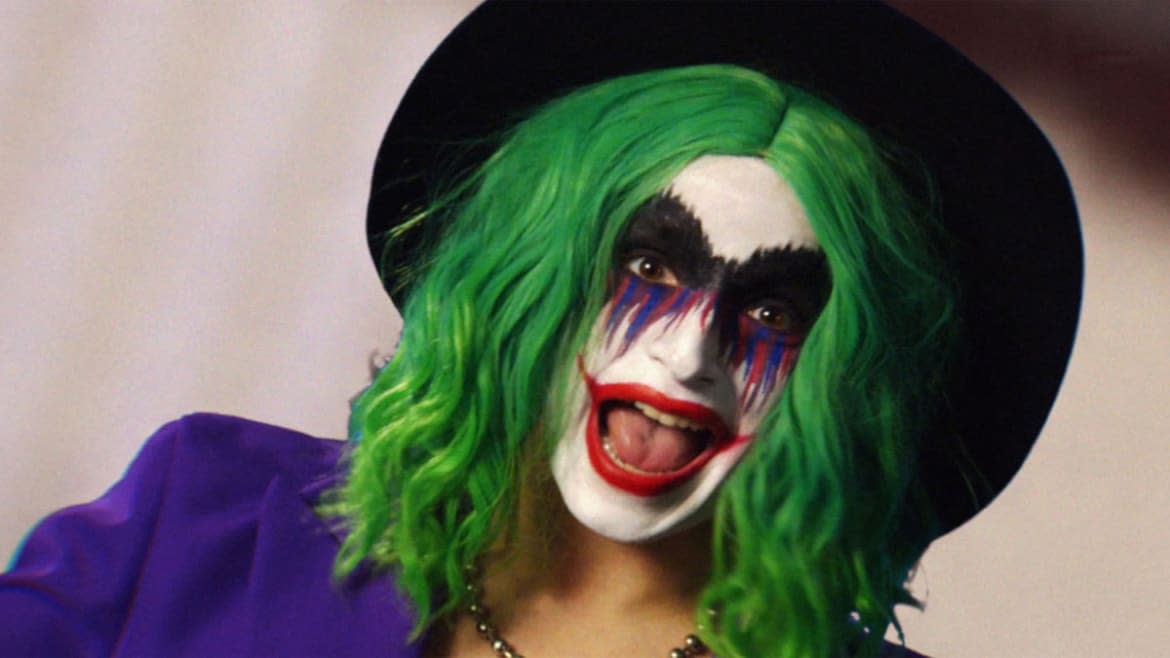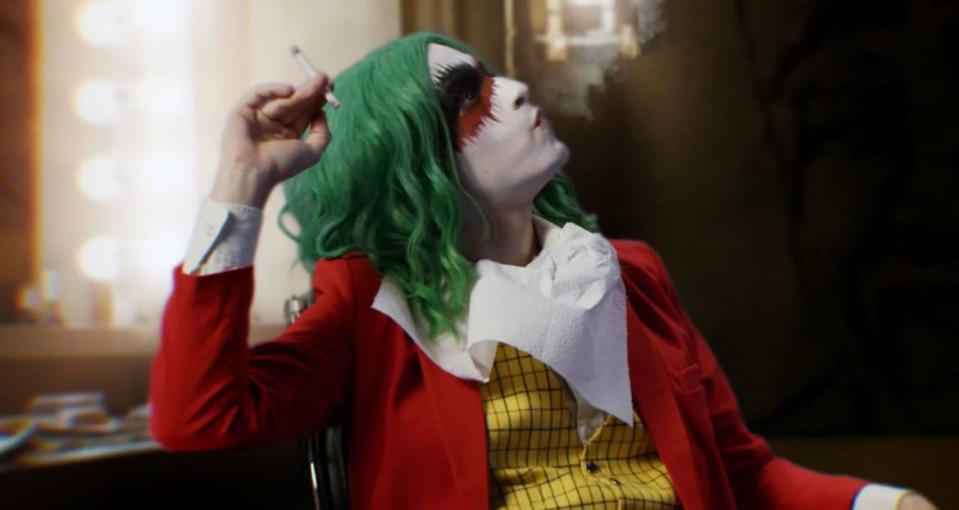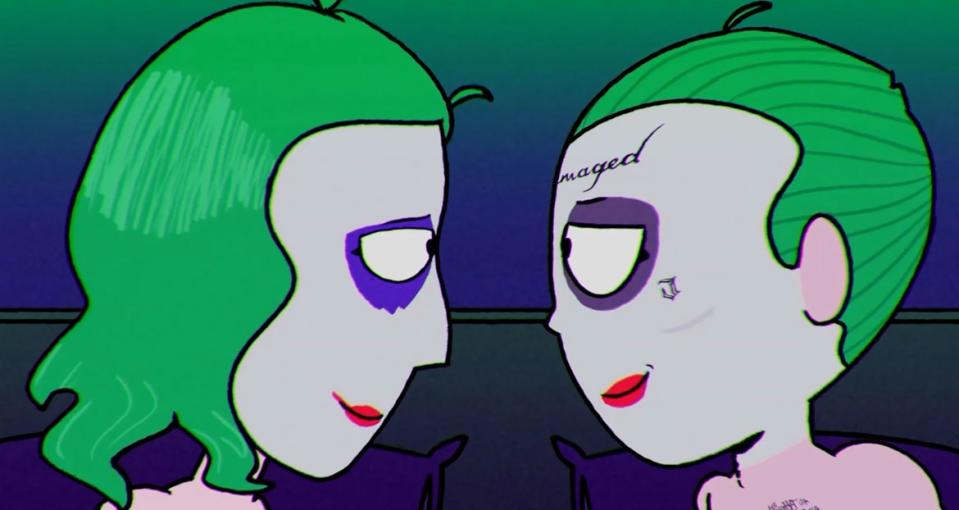‘The People’s Joker’: The Trans Artist Whose Batman Parody Pissed Off Warner Bros.

Vera Drew swears that she’s not just trying to sell tickets when she says that the new version of The People’s Joker, which hits theaters April 5, is “a completely different movie” from the version she brought to the Toronto International Film Festival two years ago.
“Legal baggage aside, the TIFF cut was really a fresh paint job,” Drew told The Daily Beast’s Obsessed in a recent interview. “It was still my favorite screening of all time, just because it was the first time I got to watch it with a crowd, but the movie just wasn't done.”
The People’s Joker staged its world premiere at the 2022 festival, but got removed from the line-up after just one screening, thanks to what she calls an “angry letter” from Warner Bros., which Drew clarified was not a cease-and-desist. From there, the film’s path back to the big screen has been a long and illuminating odyssey—one that illustrates the very point Drew’s hallucinogenic film sets out to make. When big corporations co-opt our modern myths, it’s we, “the people,” who pay a steep price.
From its very first scenes in Smallville, it’s obvious that The People’s Joker is a parody. The coming-of-age film—co-written by Drew and Bri Lerose—repurposes classic Batman lore to illustrate Drew’s coming-out journey as a trans woman. Her sardonic protagonist, an aspiring comedian who adopts the stage name Joker the Harlequin, styles herself as a blend of the Joker and Harley Quinn. Her pronouns are “he” and “ha.” Ever since she wrote her script four years ago, Drew has had “a lot of conversations with lawyers” to confirm that the incorporation of the Batman characters and material is legally protected as a “fair use” of the material. Evidently, however, Warner Bros. did not get the joke.
Despite the aforementioned letter, Drew said that the studio has not bothered spending money on litigation and never followed up with any feedback for her to satisfy. Instead, the changes she’s made to her film since its debut mostly had to do with music rights and dialing the film even closer to her tastes.
“I grew up on really rude movies,” Drew said. “I’m like a recovering edgelord, I guess. I'm a huge John Waters fan. I’m constantly ripping off Kenneth Anger, and love Bruce LaBruce. I’ve always felt like queer cinema kind of is supposed to be subversive.”
Growing up, Drew watched a lot of The Jerry Springer Show because it was one of the few places where she could see women like herself. Her older family members still think she leads an “alternative” lifestyle. So why should her movies ever bother straining to fit into some kind of cis-heteronormative, patriarchal box? The anti-capitalist sentiment underpinning The People’s Joker is inherently tied to its queerness; the film is a rallying cry against all of the interconnected forces that stand between marginalized people (and artists of all creeds) and full, unmitigated self-actualization and expression.
“I very consciously did not want to make something that was like, ‘I’m just like every woman—this is my story,’” Drew said. “No. I identify my transness with the Joker because I literally live in a society that fucking villainizes me and people that look like me. So why wouldn’t I make my art about that?”

Vera Drew
As busy as she’s been with The People’s Joker, Drew is already hard at work on another coming-of-age story as well—a “body horror cult comedy” that she describes as the Evil Dead II to the People’s Joker’s Evil Dead. For now, however, she’s mostly basking in the glow of her debut film’s hard-earned release.
“The industry is so fucking bleak right now—I'm sure you see it when you interview people—but I don't feel it,” Drew said. “Because I've just had this beautiful experience of seeing how much people still care about movies like this.”
The challenges Drew has faced over the past two years speak to her film’s radicality. This alt-comedy inflected visual collage features animation from more than 100 artists, whose work Drew marshaled during the pandemic. The story is autobiographical, but it also goes a layer deeper to examine how a cultural fixation on binaries—male and female, hero and villain, tasteful and tawdry—inherently harms us all.
As a writer, Drew draws thick, neon parallels between her experiences of dysphoria and the villainization of classic Batman characters. Her character’s unnerving, Joker-ly grin stems from a fictional drug called Smylex—which a quack doctor prescribed to her as a child to mask her gender dysphoria. When Drew’s Joker arrives in Gotham to pursue comedy, she discovers that things aren’t much better in the big city. Comedy has been banned, save for in one club run by Lorne Michaels. At the UCB (here, the “United Clown Bureau” rather than the “Upright Citizens Brigade”) dues are expensive, and men get to be comedians while women must play sexualized harlequins.
Inside ‘The People’s Joker’: The Unauthorized Batman Movie Warner Bros. Doesn’t Want You to See
After flunking out of the government-sanctioned comedy program, Joker the Harlequin finds her identity by starting an illegal comedy club alongside the Penguin (Nathan Faustyn). She falls into a toxic but illuminating relationship with another Joker, Mr. J (Kane Distler, styled like Jared Leto from Suicide Squad) and soon learns that Batman, Gotham’s autocratic Dark Knight, is also a pedophilic groomer.
Throughout the film, Drew emphasizes what we lose when powerful institutions (like the government and large corporations) co-opt our art, and by extension our means of self-expression, for financial gain. What does it mean to hand our modern myths over to those who have a vested interest in selling us an over-simplified, black-and-white version of the world for their own gain?
Although the studio apparently never followed up on its letter, Drew said that “the perceived Warner Brothers baggage” still created a few stumbling blocks for her Joker to overcome. Before the TIFF kerfuffle, she said, The People’s Joker had attracted interest from a few big-name distributors. After the letter, all of that went down the drain. Similarly, Drew found that “every single music publisher in the business” was reluctant to work with her—which meant that she had only a few months to retool her soundtrack and retime it all to fit. If the process sounds exhausting, that’s because it was.
“But that’s what the project's been,” Drew said. “I mean, the movie is very much like an impossible-to-make movie that was somehow made.”
And so, like many a DC villain before her, the director was forced to go rogue. She began to coyly promote her film through secret screenings at film festivals, all the while speaking with lawyers and biding her time until the film could stage its wide release in earnest. “I was pretty devastated initially,” Drew said, “but it quickly became really freeing, because I could just kind of make it about finishing the movie again. … I always knew that the pathway to where we are now was really just screening it again.”
Although Drew’s agent was not exactly eager for her to begin showing the film again after what went down at TIFF, the secret screening route felt like a safe way to go.
“If a film festival said in their program, ‘secret screening tonight’ and the plot was ‘an unfunny transgender clown comes of age and faces off against a queer cape crusader’ … [people in the know] would assume it was The People’s Joker,” Drew said. “And if they didn't, they’d be like, ‘That sounds crazy’” and want to see it anyway.
The secret screening tour took Drew all over the world, from Australia to White River Junction, Vermont—a small, unincorporated village with its own film festival.
“It’s literally, like, a block, a train station, and a haunted hotel,” Drew recalled of the White River Indie Film Festival. “And then, their theater.”
Regional events like these were crucial to Drew’s success, and her appreciation for the safety and validation they provided was palpable. During the White River festival, she said, “Everybody in the state of Vermont that knew about this movie showed up to that screening. It was beautiful, and I met this amazing community of queer artists.” As exhausting as this process has been, Drew said, it’s also restored her faith in making art.
“I really did just make [The People’s Joker] for 13-year-old me, which is probably the most authentic me,” Drew said. Every time she’s screened the film, she’s felt more deeply connected not only to herself but also to the queer community.
“I never could have imagined a lot of the conversations I’ve had with people after screenings,” Drew said. The response to her film so far has felt like some weird, beautiful dream—“people crying and hyperventilating and having the time of their lives.”
How the Wild, Over-the-Top ‘Palm Royale’ Havana Party Came to Life
Parents of trans people have approached her multiple times with the same look on their faces, Drew said—“like they got hit with a two-by-four.” At the same time, she observed, “there’s peace” to their reactions. “I had a mom come up to me, and she was like, ‘Thank you for making this. I know how to talk to my daughter now’ I never could have imagined getting that response from people, from this film. …It’s because we really portray queerness in this honest, optimistic, but still edgy way.”
The People’s Joker finally found its distributor in Altered Innocence, a company dedicated to releasing and preserving LGBTQ cinema. Drew had hoped to link her film with a queer distributor with a genre sensibility who also “got” art film, and this outfit ticked off all the boxes. “It was a really long road,” Drew said, “but it’s turning out to be what it was always supposed to be.”
Because Warner Bros. offered no feedback on The People’s Joker’s content, Drew’s biggest challenge in preparing the film for wide release came from the soundtrack. The original cut danced to the tune of several covers that Drew could not clear because of reluctant music studios. Thankfully, a few of these songs—including a truly excellent Prince parody—stayed in because they were “textbook” fair use cases. Still, the majority had to go. The bright side? When Drew went back to the artists she’d worked with and asked if she could use some of their original songs instead of the covers they’d recorded, they were all thrilled at the chance to show off their own work.
As disappointing and stressful as it might’ve been to retool most of her soundtrack in just a few months, Drew is actually even happier with the final result than she was before. “It flows better,” she said. “I feel like it matches my voice, the voice of the characters, and the voice of the community that made it as a whole so much better. For a movie that's clearly a parody … I think the music really helps it feel like an original thing.”
As long as Drew’s (anti-)hero’s journey back to the big screen might’ve been, there’s something fitting about The People’s Joker debuting in 2024—a year when trans cinema has flourished. Jane Schoenbrun’s We’re All Going to the World’s Fair follow-up I Saw the TV Glow was one of the hottest premieres at the Sundance Film Festival this year, as were Theda Hammel’s John Early comedy Stress Positions and the Will Ferrell-Harper Steele road-trip movie Will & Harper, and that’s still only scratching the surface. As Drew put it, this marks “the trans-est year of cinema that I've ever seen in my entire lifetime.” In that sense, it feels like fate that The People’s Joker is also coming out this year.

The People's Joker
While Drew does not think her film should be a model for other filmmakers—“especially if you're a first-time filmmaker, don't run out and make The People's Star Wars or whatever,” she said—she does hope that her project can become a call to arms for queer people to make more fun genre films.
“We can do it!” Drew said. “We can talk about our trauma in them; we can talk about real things, and our families, and they can have all the trademarks of queer filmmaking. But we can make fun genre movies, and you can make them in your house. … If I can do this in my backyard, I think everybody can.”
When asked if a streaming release might be on the horizon, Drew seemed hopeful. There will also “probably” be a physical release at some point. At the same time, she emphasized that The People’s Joker is best seen on a big screen. “It’s meant to be viewed with your chosen family in a theater after you’ve hopefully had dinner and a drink or two—or a smoke or two,” she said with a grin. “I want this theatrical run to last forever. I want this to be a midnight movie. I want this to be playing after I die in 150 years.”
With any luck, it will. If there’s any kind of clown that can start a movement, it’s Joker the Harlequin.
Get the Daily Beast's biggest scoops and scandals delivered right to your inbox. Sign up now.
Stay informed and gain unlimited access to the Daily Beast's unmatched reporting. Subscribe now.


